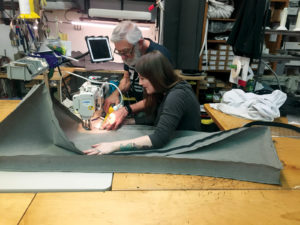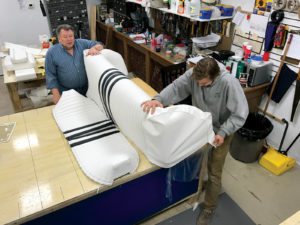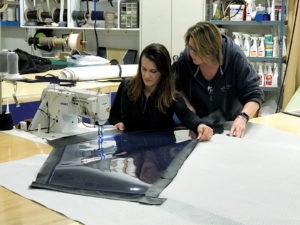Train, recruit and keep employees
 Competition, especially from overseas manufacturing; increasing costs for equipment, materials and labor; the need to keep up with fast-paced technology; and the general state of the economy, which directly affects the consumer pool, rank as challenging issues for most businesses. Yet the owner of a marine fabrication shop in Portland, Ore., has a more pressing concern.
Competition, especially from overseas manufacturing; increasing costs for equipment, materials and labor; the need to keep up with fast-paced technology; and the general state of the economy, which directly affects the consumer pool, rank as challenging issues for most businesses. Yet the owner of a marine fabrication shop in Portland, Ore., has a more pressing concern.
“Recruiting, hiring and retention [of employees] are our biggest challenges here,” Wyckam owner Amy Poe says. “In the 19 years I’ve owned my shop, I’ve had more than 30 employees. Most people view this type of job as a temporary one. Because we are a sail loft, they want to hang out for a bit, learn about sails and sail repair, hang out with the sailors, then in a year or so move on to a ‘career.’ We have stopped recruiting in the sailing community, and yet that is still where most of our applicants come from. Our focus has shifted considerably from sails to industrial fabrication (shade sails, trade show and event fabrication, etc.), but it is nearly impossible to find employees with experience in that area.”
Clint Halladay, lead fabricator and production manager at Sewlong Custom Covers in Salt Lake City, Utah, says his company has struggled lately just getting applicants.
“I think [popular] culture is about constantly chasing your passion instead of owning your craft,” he says. “Building boat covers is rarely someone’s passion. When I applied here, I was not interested in building boat covers. I just wanted to make backpacks and, lo and behold, since learning the industry, I love my job.”

Rick Burgin, a soon-to-be-retired employee of Sewlong Custom
Covers, trains Amanda Robison-Stenquest on sewing techniques
for cushion upholstery.
Coaching the players
Most companies call the people working for them “employees.” But small marine fabrication shops tend to refer to those on their payroll as “team members” and “teammates.”
Although the owner of Lake Shore Boat Top Co. in St. Clair Shores, Mich., says his toughest recruitment challenge is finding individuals with relevant talent and experience, he’s after other qualities.
“We are foremost looking for someone who will fit our team dynamic,” Rob Kotowski says. “We look for someone to be cross-functional—who is willing to step in and help the team complete a project, even if it means they get pulled off of what they are accustomed to doing.”
Canvas Innovations of Holland, Mich., has eight “teammates,” ranging in age from 23 to 56. Owner Chris Ritsema says his main workforce challenge is “the time invested to get new employees trained to our standards.” And he does not limit those standards to technical skills.
“I am really heavy on relational culture,” he says, noting that his company follows an interview format that includes a discussion on the resolution of conflicts among co-workers.
“We ask probing questions to see if they care about keeping the working environment healthy and are solution oriented,” Ritsema explains. “If an individual is confident in their skill set, we let them know we will be retraining them and they need to adapt to our culture. If someone tells us they have 25 years of experience, we say, ‘That’s a good quality, but we have a pretty specific way we do things and want to be sure you are open-minded to that.’”

Lake Shore Boat Top Co. owner Rob Kotowski’s father, Bob Kotowski, works hand in hand with employee Nick on a rolled and pleated rear bench. Kotowski is coaching Nick to become the company’s lead upholstery staff member.
Lake Shore’s and Sewlong’s workforce profiles match closely, the former employing seven individuals between the ages of 22 and 63 and the latter with the same number of workers between 28 and 66 years of age.
During the interview process, Sewlong’s Halladay looks for indications that job candidates possess motivation and good communication skills.
“We have a list of values that we try to keep consistent in the shop,” he says. “The biggest issue that we run into when we hire skilled individuals is that they come in feeling like they already know how to do things and don’t want to adapt to the way we do things. We want to do a project so it looks like our shop did it as a team.
“The last two people we brought on had no experience in marine fabrication, so we are in the process of teaching them as much as we can in an orderly fashion,” he continues. “We are becoming better trainers of our craft, so they are learning faster. We used to throw a whole bunch at [new employees] at once. Then we realized we need to get them up to speed one thing at a time.”
Wyckam, which has had employees ranging from 17 to 60 years old and currently has three employees in the 30-to-50 age bracket, looks for “people who are capable of thinking three-dimensionally and through a process to get the desired result in a timely manner,” Poe says. From that pool, she looks for people who are “excited about fabricating canvas and want to stick around long enough to become skilled at it.”
Nancy Struthers, owner of Canvas Complete in Summerstown, Ontario, hires primarily seasonal workers ages 16 to 64. She says training them isn’t difficult, but it is time consuming. Her primary challenge is that most people want year-round work. Also, she’s found that many young people have unrealistic expectations of the job market. “Twenty- to 25-year-olds who have gone to school and have not found employment in their field are expecting high hourly wages right away.”

At Lake Shore Boat Top Co., Phyllis works alongside and teaches Diana, a new staff member. “Diana has been with our team for roughly 90 days and has gained great ground as team members have helped her gain confidence in working to our standards,” owner Rob Kotowski says.
Goal tending
Hiring and training new employees are just two legs of the metaphorical stool. The third leg, which is critical to stability, is retaining team members who fit the culture, develop their skills and show dedication to the company’s goals.
To cultivate good teams and instill loyalty among them, employers need to provide a positive environment and career pathways. As for the former, Sewlong maintains what Halladay calls “a fun culture.”
“We have lunch once a week with the team,” he says. “Every other Friday, we go to a bar across the street after work and shoot pool and play shuffleboard.” In addition, company owner Justin Jones hosts a long weekend for his staff at his family cabin on Scofield Reservoir and annually rents a houseboat at Lake Powell for a team getaway.
Poe follows a similar practice for making Wyckam employees feel appreciated.
“Because many of our employees are sailboat racers, we allow them time as needed to make it to the evening races,” she says. “We also have company barbecue lunches and occasional weekend sails. We always celebrate birthdays, and we reward our employees with bonuses when we have a particularly successful project or year.”
Canvas Innovations brings in lunch to celebrate employees’ birthdays, supplies donuts and Starbucks coffee quarterly (and occasionally pizza) and organizes company trips that have included chartered boats and a tour of Chicago.
In addition, Ritsema sends teammates to trade shows. “It gives them a sense of belonging and helps them feel a part of something bigger,” he says. “When they meet vendors and other people in the industry, there is a connection to the network of what we do. They come back with fresh ideas. And it convinces them that we are willing to invest in their future.”
Businesses that want to set their employees on a progressive path need to ensure a system of goals and salaries that reward accomplishments. Sewlong maintains a training chart that outlines an employee’s tasks.
“We sign off on those tasks and give raises based on that spreadsheet, so there’s very clear direction for them on how they can progress and increase their pay,” Halladay says.
According to Kotowski, Lake Shore Boat Top changed when he stopped “just looking for help” and started looking for individuals who wanted careers.
“We sit down with each member of our team and try to get a feel for what their career objectives are,” he says. “We set a lot of short-term goals, and we also set long-terms goals for them. We plan a future for them, and it is up to them to work hand in hand with us to get themselves there. We conduct employee evaluations every three, six and 12 months. This is a great way to really see how their goal setting has worked. If they might be sliding off, it is our job to help guide them back on track.”
Canvas Innovations surveys employees in a monthly review meeting, asking them what tools the company needs to provide them and if there is something that management is not doing effectively to help them in their jobs.
“It’s not only about what they can do better, but what the company can do better,” Ritsema says.
“Our core value is ‘people matter,’” Halladay says. “We empower our team members to take ownership in the company and make decisions based on what they think is best for the customer. If they take care of our customers, our customers will take care of the company.”
Janice Kleinschmidt is a writer and magazine editor based in San Diego, Calif.
 TEXTILES.ORG
TEXTILES.ORG 






